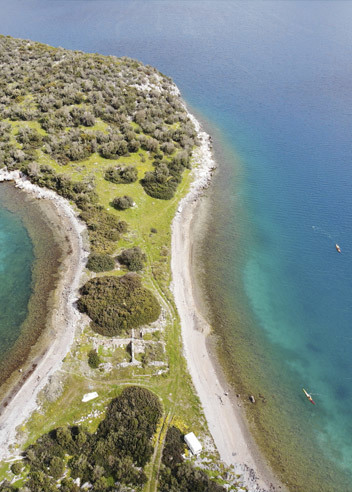

Full day Sea Kayak tour in Skorponeria fjord, Central Evia
5 hrs
from €75
The first indigenous tribes moved from Africa in order to benefit from marine activities to seek and better preserve food, this is why they opted for places with a temperate climate and sea. Later, the first hierarchical societies had an immediate need for trade to ensure their prosperity.
Trade created local economic prosperity but also brought together the different cultural characteristics of the 'known world'. This is, after all, how cultures evolve, when they intermingle and a variety of choices and stimuli prevail. In today's Greek territory we can see ancient ports that are a landmark for the historical development of specific regions. Today we will briefly look at the symbolic character of the port of ancient Anthidona.
The port of ancient Anthidona is located in the much-affected Evia. A place that constantly proves to us that it is a Mediterranean paradise on earth, or as Greek Mythology best describes it, a place loved by the Olympian Gods (and not only) because of its unique natural beauty!
We could even associate it with the heroic Makarian Islands of Hesiod, if it weren't for an estimate of roughly where they are today. However, through important archaeological discoveries, we know that Evia has had and continues to have human activity since the Paleolithic era (80,000-10,000 BC). This enables us to understand the symbolic place of Evia in the world's Ancient History.


The port in ancient Anthidona is located today on the coast near Loukisia, 15 km northwest of Chalkida. Its special name is a landmark for the mythology of the region. Although the word Anthidona, with a first conceptual analysis means "blossoming", that is, "Blooming City", the testimony of the geographer Pausanias tells us two different versions. The name in the first case comes from the nymph Anthidon, while the second version states that it comes from King Anthas, son of the Olympian god Poseidon and the daughter of the titan Atlas, Alcyone.
Current research has revealed that it was inhabited as early as 1180 BC! In fact, its period of peak prosperity was between 60-70 BC and it is known in history for its great shipyards. According to the historian Diodorus Sikeliotis, during the Peloponnesian War, the Thebans decided to build a hundred triremes in this port, thus Anthidona evolved into the port of Thebes.
However, based on the references in the Homeric texts, it turns out that it also took part in the Trojan Expedition. The main source of income was the fishing of porphyra, a shellfish that was prevalent in the area, and then the dyeing workshops based on the colour of this particular shellfish.
The town was an important communication link between Boeotia and Euboea and it is the style of construction of the harbour that stands out. It was one of the first spacious and at the same time well-protected harbours! Despite the strong northerly winds it had remained unscathed by enemy raids. Here the ships of the Ancient Phoenicians dropped anchor to obtain the shells for the production of the famous dye. Also, according to tradition, the impressive "Argo" departed from the port of Anthidona for the expedition that brought the Golden Fleece.
First-hand testimonies of the period:
During the Byzantine years, many barbarian raids took place, causing the area to decline. More specifically, from 1350 until the late Byzantine years, the inhabitants were forced to retreat to the interior of Mount Messapio (Ktypas) in order to establish a new community to breed animals, the present-day community of Loukisia. It was then that the church of St. George was built, which provides us with important information about the mentioned years.
Excessive fishing in ancient times for the purpose of exploiting the porphyra led to their significant decrease and today we can observe scattered pieces of them on the surrounding beaches. Finally, the abandonment of the harbour led to its total decline over time, although it remains the only ancient Greek harbour that is so well preserved today. [1][2][3][4]
Yannis Georgiou / Graduate of the Department of History and Archaeology.
Athens, 26/1/2023
[1] Strabo, Geographics, Book I 404,i
[2] Pausanias, Attica, ch.23,3
[3] Homer's Iliad II (verse 498,500). Translation (by James Polyla). Ancient Text, Translation and Commentary , Rhapsody II - (Book 2). The Dream of Agamemnon and the List of Ships
[4] . M.H. Jameson, New Inscriptions From Anthedon